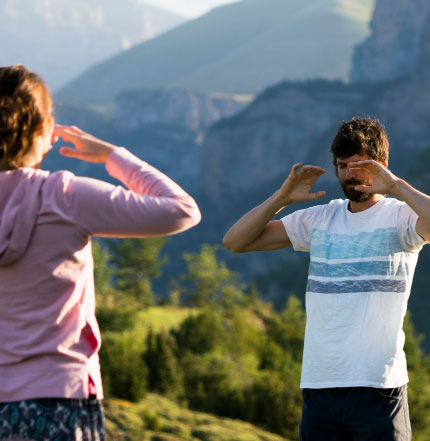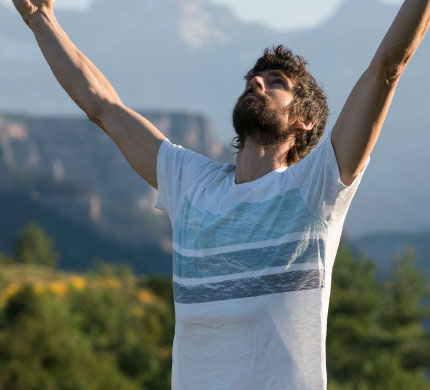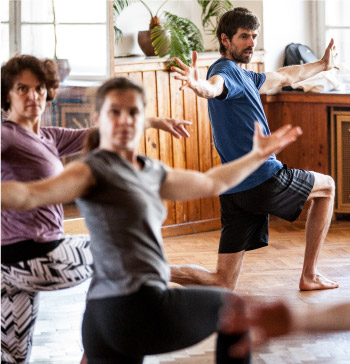
James Boag – This Yoga
“James Boag teaches yoga, but not like others.”
– Aparna Sridhar –
of guts, heart, and head
of loins, heart, and brain
of spirit, soul, and senses
of body, mind and emotions
The yoga I practice is timeless yoga, rooted in perennial, ancestral wisdom, the yoga that was time-tested, thoroughly peer-reviewed and empirically proven over many, many generations before it was set down into the miracle, mirror texts that encode its practical teachings in so many complementary ways.
The yoga I share is of story and song, of movement and dance, of inquiry and commitment.
The yoga of Kashmir Shaivism, as it has come to me, is a yoga that embraces all of life.
Everything is divine.
Everything is the means.
There is nowhere God is not.
This is a yoga of rhythm and reconciliation, of inclusion and harmonisation.
This is a yoga of acknowledgement and recognition, of healing and recovery.
This is a yoga of diligence and joy, of forgiveness and gratitude.
Yoga is for spiritual heroes and heroines: those who are willing to wrestle with all it means to be alive, now, as a human; those who are willing to step beyond conditionings, out of our revolutionary history and forge the way of the evolutionary; those who are willing to apprentise themselves to the wisdom of the Mother, who knows how to Womb it: to create something more beautiful than we might even have dared dream from within what already is.
This yoga is for those who are ready to embody authentic humanity, owning that there is a cosmic intelligence infinitely vaster than our minds or technologies can grasp, yet which our organism is an intrinsic and magnificent part of.



Yoga practice is about cultivating sustainable harmony.
Yoga is about fulfilment and freedom, becoming all
of who we really are, our whole, true self.




Whole Life Yoga
This whole life yoga is quite different from some of the other offerings out there that are called yoga. ‘I teach yoga’, but what I do may be quite different from what those words might make you imagine. My work is about including, inviting, gathering; about acknowledging, reconciling and integrating. It is the yoga – balance, harmony, sustainable easefulness, skillfulness, integrity – of the whole human being.
The principal methods I use to explore this are:
- broad spectrum yogic movement
- practical, applied yoga philosophy – robust, time-tested, antifragile
- meditation and awareness practices
- storytelling, song, sound
- inquiry, circle, council
I have been apprenticing myself to the art, science, craft, and discipline of teaching and communication for more than three decades, for most of my life. I have taught regularly since I was 16 years old. Yet I do not really believe that anyone can teach anyone anything. The best we can aim for as a teacher is to create/foster/invite a situation in which learning is more likely to occur. I see three foundational factors to facilitate this:
One: Teaching as ongoing studentship
Two: Teaching as Vocation
Three: Holistic, Yogic teaching method
Values and Principles Underlying This Work
What do I Believe?
Well, I think beliefs are very dangerous, however, I can say for myself:
- I believe life is a gift, an opportunity to learn, to grow and transform ourselves more fully into who we really are.
- The best things in life require effort, care and attention.
- I think it is foolish, hubristic and short-sighted to dismiss the wisdom of dead writers or the great deeds of historical figures because they also expressed views or committed acts we condemn or find uncomfortable. We do not need to put the teacher on a pedestal to recognise that the teaching can help us grow.
Time-tested teachings are to be treasured and worked with.
It is foolish, hubristic and self-sabotaging to presume that wisdom that has survived millennia is primitive or less ‘validated’ than knowledge that has been gained in a ‘modern laboratory’ or tested in a peer review setting. Ancient teachings and scriptural stories that have survived thousands of years have only done so because they were peer review tested over many generations. We dismiss them at our peril.
We are here to evolve.
May we embrace the way of the evolutionary and escape the vicious cycle of our revolutionary history: railing against the detested and disprized we become what we despise and one unjust structure replaces the one it purported to be against. The names change but the same old system is perpetuated. Instead, let us be for a new way. One that is wise and courageous enough to acknowledge that despite our ancestors’ failings, they did much amazing work, that despite the problems within the current ‘system’, it nonetheless contains much of value. Our task is not to rail against the past, but to learn from it so we may build and bring forth a present more beautiful than we might ever have dared dream was possible.
We can womb it.
What do I mean? The Mother is one of the great archetypes of the Yoga tradition. What does the Mother know? Not intellectually in terms she can label and define, but much deeper, in the pulsating heart of her cells? She knows how to womb it – how to create something more beautiful than she would ever have dared dream was possible from within the existing structure, without tearing it down, but actually enriching it and drawing on its deeper, perhaps previously untapped potential.
As humans, we all have a ‘recreational’ capacity to reform and reshape our understandings, of ourselves and of existence.
When we engage with life ‘playfully’, exploring beyond the previously known and familiar, we can recreate our understandings.
Competition is (or at least certainly can be) a thing of great beauty and purpose.
Competition and competence often go together. Genuine competition is not to beat the opponent, but to lift everyone up, to draw forth the deeper competence that is so hard to uncover without the stimulus of the other and the example to live up to. The root of the word rival is two rivers that run in parallel, both flowing to the sea of wholeness. Only when we work with our rich array of human capacities and strive to bring our competencies together will we uncover our real capacities and know satisfaction and fulfilment.
Fulfilment is a wholehearted endeavour.
You do not experience fulfilment by doing things half-heartedly. If it is worth doing, it is worth doing properly.
- Doing things properly, authentically, in the way that resonates through the core of your body, is the way.
- The way of yoga is broad and inclusive. It includes many, many streams and currents.
At the same time, there is only one way: your unique way.
We can learn a lot from others, from those who have gone before, but you are unique and you have to walk your own path.
You need to be valiant and courageous to keep striving forwards in the unique expression of you. - The colour of truth is grey. And we only see the rainbow in the grey. Life is a realm of duality: birth and death, day and night. But it is not merely binary. We live in a realm of pied beauty and infinite nuance. As André Gide has it: ‘seek the company of those who are genuinely seeking the truth. Beware of those who claim to have found it.’
The attitude of inquiry is foundational.
Truth will set you free. But in the search for Truth we will encounter the prison walls we ourselves have erected, the manacles we have allowed ourselves to be clasped in, the confines we have adhered to. When we see that we have been agents in our own sabotage, it is tempting and all too easy to turn a blind eye, all too easy to turn the discomfort this brings up out onto some convenient scapegoat or other.
The key practice is to learn to chew, swallow, digest and assimilate our own ignorance, to draw out its lessons and then leave behind what no longer serves us, avoiding letting the toxic waste of our egoic adjustment come out sideways in negativity that condemns ourselves to suffering and brings little benefit to those around us.
This body, this earth, this life: are sacred.
Some people believe in guardian angels that hover over our shoulders. They may be onto something. I know though that there are angels in our shoulders. Indeed, there are angels throughout the whole of our bodily vehicle, the result of millennia of evolution. The body contains so much wisdom and intelligence. It is our human duty to work with it. Collaborating with the intelligence of our body can help train us in collaborating with the intelligence of the body of our home this amazing ecos.



Who Are You Working With?





Programs
SIGN UP >

Work With James
LEARN MORE >

Store
COMING SOON
Whole Life Yoga Newsletter
The place to find out first about all James’ programs and offerings, receive articles, recommendations, and access special rates for programs.
